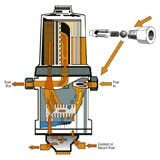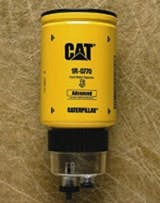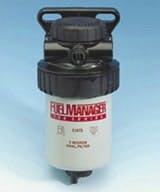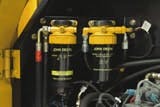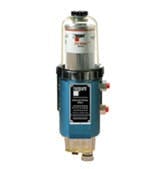Caterpillar
For information visit www.cat.com.
Stanadyne
For information visit www.stanadyne.com.
John Deere
For information visit www.johndeere.com.
Fleetguard
Water gives life, but it will kill an engine. If not removed from a machine's fuel system, that life-giving water will rust and corrode engine parts. Fuel-water separators pull the water out of the system.
Just because a product claims to remove 100 percent of the water doesn't quite tell the complete story, though. There are two types of water, says Greg Skeels, filter and fluids technical manager for Caterpillar. One is what he refers to as "whole water," and the other is emulsified water.
"Think of whole water as drops," he says. "Just about everything out there will remove close to 100 percent of whole water. It gets into the fuel because, more than likely, it's in the tank at a fueling station. It can also get into the system as the fuel is used because the system heats up and cools down. And, too, atmospheric moisture can condense and get in."
Hard-to-remove emulsified water usually starts out as whole water, says Skeels. As a piece of equipment bumps, bounces and jars its way across a work site, the fuel sloshes around. The more it is stirred, the finer the water particles become, says Skeels. As a result, they are dispersed throughout the fuel and eventually end up in an emulsion, which is difficult to separate.
John Clevenger, Cummins Filtration, cautions fleet managers to make sure any fuel-water separator eliminates both "free water" and emulsified water. Cummins markets the Fleetguard brand.
"I call it medical-quality fluid cleanliness levels for the fuel system," says Clevenger. "When you think about it, you're putting in a bunch of dirty fuel and you're trying to get out all that stuff before it reaches the engine."
Free water is visible, he says. "If you put it in a jar, you can see the water sitting on top of the fuel. That's very easy to remove because it's basically already separated. Emulsified water, on the other hand, has been mixed so well into the fuel that it is composed of very, very small bubbles that are almost attached to the fuel."
Water also emulsifies as it is transfered through lines, storage tanks, regional storage tanks, tanker trucks and underground storage tanks. "Every time you pump the fuel, you mix it and emulsify the water," Clevenger says.
Fuel-water separators should be considered from two standpoints: the efficiency of the unit to remove particles and its efficiency in removing both types of water.
"There are a lot of products on the market that remove particles of 20 microns or better," Skeels says. "From Caterpillar's standpoint, we prefer that everything be 10 microns or better when it comes to particles. But it is the water-removal part where a fleet manager has to be careful. Removal of emulsified water should be in the low 90 percent range."
There are other factors fleet managers should be concerned with as well. "One of the first things is to find out what the equipment requires," Clevenger says. "The engine may or may not require a fuel-water separator, but that doesn't mean you might not want to put one on. Another factor is to determine what your objectives are as an equipment owner: to keep the unit for a long period of time, to extend PM intervals, or to simplify service?"
Answers to those types of questions, says Clevenger, will determine what a fleet manager should look for in a fuel-water separator. Clevenger identifies three types of fuel-water separators. One is a standard, on-engine spin-on type; another is a remote-mounted spin-on; and a third is a remote mount housing, which Fleetguard calls a processor.
"The spin-on type comes standard on an engine," says Clevenger. "The remote mount spin-on is mounted on the frame rail or some other off-engine location and may have things like primer pumps or heaters. It will have a spin-on filter and many times a clear, plastic bottom bowl."
Remote mount housing has a self-contained water separator system that is also remotely mounted on the frame rail. It has a number of benefits, Clevenger says: clear covers, clear bottom bowls, heaters, water and fuel sensors and check valves.
Diego Navarro, service marketing manager, John Deere Construction and Forestry, says there are also water-separator kits available. "Some water-separator kits have water sensors, see-through bowls, hand-priming pumps, filter-restriction indicators, heating elements and self-purging valves — all options that can come in handy during equipment maintenance."
For fleets that operate in cold climates, managers should consider an add-on heater. Heaters prevent water from freezing and diesel fuel from gelling.
"A heater lets you warm up the fuel so it circulates through the engine," Skeels says. "Another nice add-on is a fuel-water sensor that goes into the filter and tells you when the bowl is full of water. This eliminates the need for draining the bowl unless the water actually needs to be drained."
Three types of heaters are available, Clevenger says.
DC heaters, which come in 12 and 24 volts, are generally considered preheaters. The ignition key is turned to the on position for about three minutes before starting the engine. It heats the fuel inside the filter envelope and allows it to flow through the filter without getting waxed up.
AC heaters can be used either as pre-heaters or as overnight heaters. In cold, vehicles are plugged into block warmers overnight. This keeps the fuel warm inside the filter envelope and avoids start-up problems. Liquid heaters use coolant or return fuels to heat the fuel in the housing, and they run all the time, says Clevenger. "Fleets use this type if they operate in extremely cold climates or if they run a high percentage of biodiesel." The advantage of fluid heat, he says, is that it puts out "a tremendous amount of heat in terms of voltage, probably equal to a 1200-watt heater."
As refined and sophisticated as today's fuel-water separators are, developments throughout the industry are making new demands and throwing down an array of new challenges for product designers and engineers.
Since the job of a fuel-water separator system is to protect the engine, and some engines are running off biodiesel, the focus now is on filter media, says Skeels .
"Biodiesel is a different animal," he says, "and we've got to figure out what is the best product solution to separate water from different biodiesel mixtures. We're doing some basic research and development on this.
"We're looking at different media designs and configurations that work better with biodiesel," he says. The primary issue is that biodiesel is a great emulsifier in and of itself. Water tends to disperse in it very early and becomes mixed and difficult to separate."
Clevenger says that as engines continue to develop in response to emissions requirements, they will require even more fuel-water separation and particle removal. "You have to take out as much water as possible with the new engines because the trend is moving fuel system pressures up toward 30,000 psi," he says. "Holes are drilled into the injectors that are measured in microns; you can't even see them with the naked eye. That's the holes the fuel is being pushed through. You're dealing with tolerances in the injectors that use to be in the thousandths of an inch. They're now moving to the 3- and 5-micron range. With tolerances like that, you can't have water because water going through a 10 micron hole will wear the hole wider. That will significantly affect the engine performance and emissions."
Navarro concurs. "Given the high injection pressures of Tier 2 and Tier 3 engines, fuel cleanliness is a must. To make sure that the fuel is exceptionally clean when it reaches the injection pump, providers are switching to two-stage, low-micron filtration."
Keep an eye on fuel-water separators, because water kills. The purer the fuel, the more efficient and long-lasting the engine and the machine.
